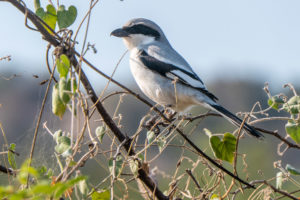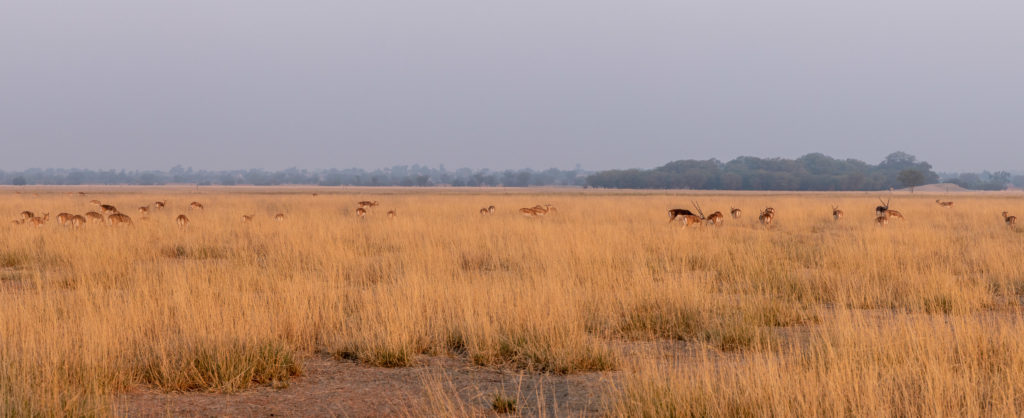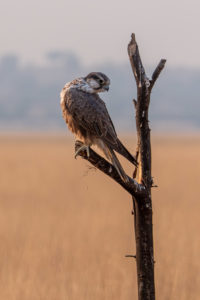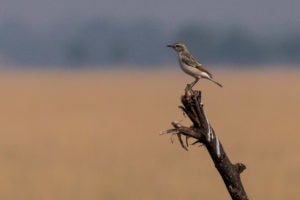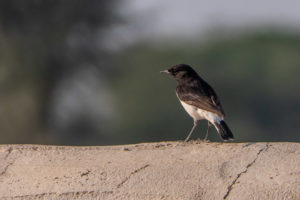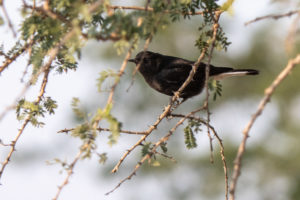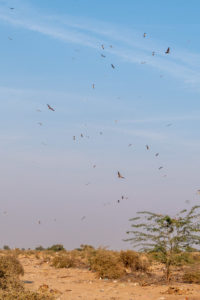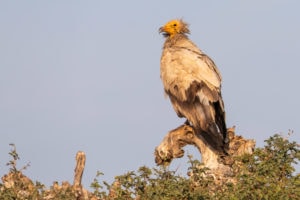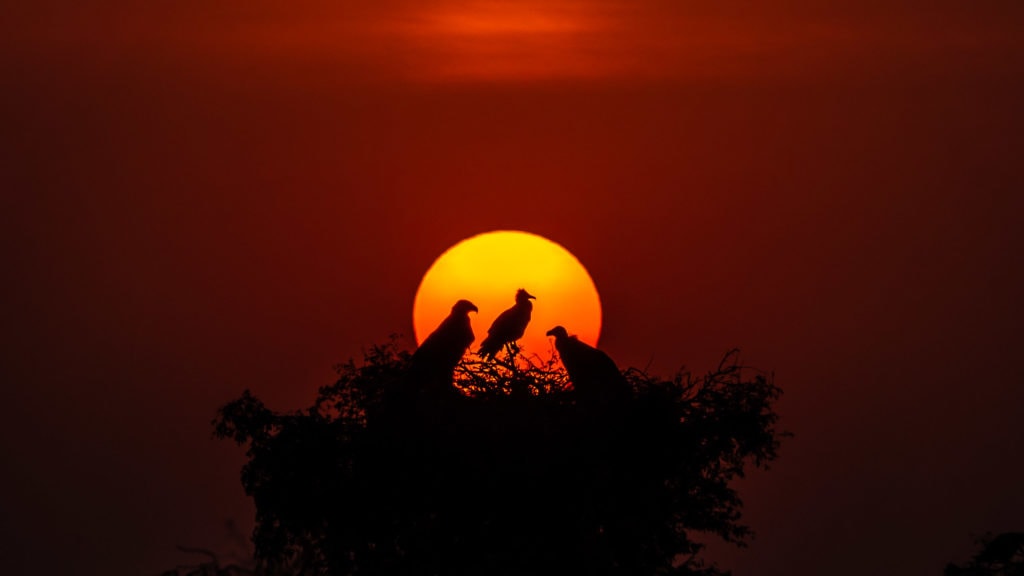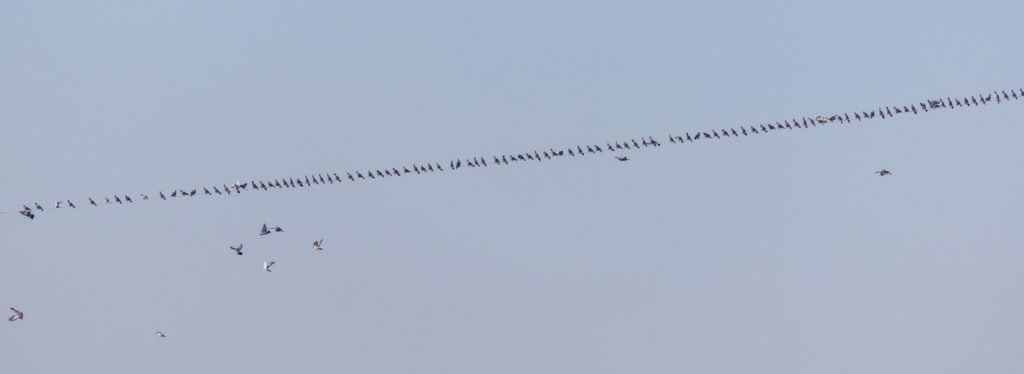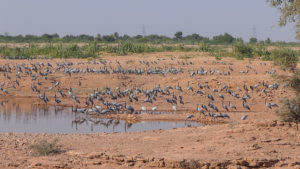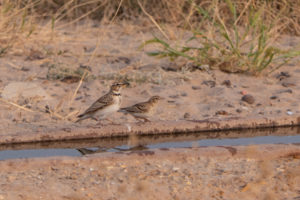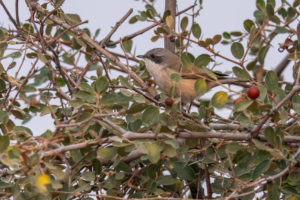Contents
Summary
The third in our series of short “Looking up from lockdown“ tours to top Indian birding destinations, taking advantage of a relaxation in COVID-19 restrictions, this time visiting two of the best desert birding sites in Rajasthan. Itineraries were designed to be easy-paced, minimising travel, and using established bases that we knew to be implementing sensible health precautions. Overall birding was as usual fantastic, and we definitely felt safer being in outside environments in remote and uncrowded places, than stuck at home in towns and cities hardly getting out!
Driving from Delhi, we spent two nights near Tal Chhapar Wildlife Sanctuary, one at Bikaner, and three at Sam in the Thar Desert. Whilst we would normally fly back from Jodhpur, we decided instead to do the long drive back, and spent a further night in Pushkar. Mohit, founder of Asian Adventures, and Vivek Menon, founder of Wildlife Trust of India, joined us for the first part of the tour. Digvijay Singh Rathore and his son Vijayaditya were present for most of the trip, finishing in Jodhpur where they live. Being Rajasthan residents, they knew most of the area better than we did, and we probably tapped their knowledge as much as they did ours! It was great to have such entertaining and educating discussions on birds and conservation in Rajasthan. Of course, with Vivek and Mohit both present until Bikaner, we actually probably discussed most hot Indian conservation topics in the course of the trip!
Altogether we saw 209 species in just over a week, including travel days. Rajasthan has spectacular birding and, more than just the species numbers, the birding experiences were wonderful. It’s hard to single out a highlight, but to end up seeing 10 different Great Indian Bustards—almost 10% of the remaining global population—was up there of course. Vivek and Mohit had left by then so missed out on this but, not to be outdone, caught up with unprecedented numbers of wintering Long- and Short-eared Owls.
This tour involved quite a lot of travel for short trip—we would normally have at least a couple more days for just the Rajasthan highlights, and there are numerous options to do the state justice, including taking in the best of Gujarat as we do on our main tour of this region. There is still plenty of scope for exploring and discovering new birding spots in Rajasthan, so do contact us if you are interested in joining us for this!

Tour Diary
Delhi to Tal Chhapar
The first day was predominantly a travel day, but we planned to arrive in the late afternoon at some thorn scrub forest near Nechwa, near Salasar, to look for Spotted Creeper.
We left early from Delhi to give us time for a couple of ad-hoc stops in promising habitat before this. Our first birding surprise was at an early morning chai stop: whilst enjoying the warming tea on a chilly and slightly foggy morning, we came across an interesting leucistic Large Grey Babbler in a flock of normally plumaged birds: it was mostly white except for brownish-black wings and central tail feathers, and flecking on the head, and had a pale pink bill and yellow eye.
Our first exploratory stop was at Raiwasa Lake, in Sikar district. This is a huge area, and with just a short stop we could not check it thoroughly. As it happened, the area we decided to investigate was predominantly dry, but a small pool held a large flock of Spotted Redshanks, some Pied Avocets, Little Stints and, most significantly here, a single Northern Lapwing. A juvenile Bonelli’s Eagle in flight was good to see, and the surrounds gave us Great Grey Shrike, White-browed Fantail, Rufous-tailed and Crested Larks, Isabelline and Desert Wheatears, and Tawny Pipit. We could easily have spent a day here to cover the entire area!
https://ebird.org/india/checklist/S76436284
Although we were short of time, an extensive area of thorn scrub on the map looked worth exploring, particularly for Marshall’s Iora, White-naped Tit and White-bellied Minivet. With less than an hour here in the middle of the day our chances were slim, so we were delighted when we found a pair of minivets, and a decent selection of overall birds. We will definitely come back here for longer on a future trip.
https://ebird.org/india/checklist/S76436299
https://ebird.org/india/checklist/S76436367
Spotted Creeper is an uncommon Indian endemic, found mainly in stands of khejri (Prosopis cineraria) trees. It has never been common and is thinly distributed throughout its known range, with so little data that its status is “data deficient” according to State of India’s Birds. However, it has definitely disappeared from some previously regular sites, and is almost certainly declining and threatened. We spent some time looking for it around Nechwa without success, although did find Rufous-fronted Prinias and White-capped Buntings. Never mind, we had another site to try over the next couple of days…
https://ebird.org/checklist/S76436402
Tal Chhapar Wildlife Sanctuary
Tal Chhapar in Churu district of Rajasthan is a remarkable site for birding and other wildlife. The main sanctuary is just 9 sq km of grassland, with a large population of Blackbuck. In fact, too large, with currently more than 3,000 present with no natural predators, meaning that the Forest Department is likely to start a relocation programme to take many of them elsewhere. The recently retired Range Forest Officer, Surat Singh Poonia, is credited with restoring the habitat to the fine reserve it is today. He also happens to be a great birder! We were fortunate that he joined us for our stay here and we were able to get the benefit of his immense knowledge about birds here, and wider conservation issues. We were also joined for some of the time by Gobind Sagar Bhardwaj, Additional Principal Chief Conservator of Forests and well-known conservationist in Rajasthan, so, together with Vivek and Mohit, we had no shortage of conversations about Tal Chhapar, bustards, floricans, tigers, cheetahs and almost every conservation issue in Rajasthan and elsewhere during the couple of days!
At Tal Chhapar we were also joined by father and son birding duo Digvijay and Vijayaditya Singh Rathore, who are from Jodhpur and thus their knowledge of Rajasthan, birding and otherwise, was excellent. As well as being an exceptionally good photographer, Vijayaditya had recently published Birds of Chandbagh, a book with a detailed summary of the birds of the campus of The Doon School. Overall, therefore, we had a diverse and extremely knowledgeable and fun group for this tour.
Tal Chhapar sanctuary is best explored slowly by car, which allows close approach and excellent photographic opportunities for the Blackbuck, Chinkara and Nilgai, and the many raptors, larks, pipits and other desert specialists here. Large numbers gather on passage in September and October here, with a bit of a lull before winter peaks. Thankfully during this slightly quieter time of year there is still fantastic variety, if not so many birds.
Our first day inside the sanctuary produced three species of harrier, Eastern Imperial Eagle, Long-legged Buzzard, Black-winged Kite, Laggar Falcon, Eurasian Sparrowhawk, and Common Kestrel, all giving fantastic views. A few Greater Short-toed Larks were seen (not the 5,000 I recorded on my last visit!) as well as Crested Lark and Indian Bushlark, Tawny Pipit and Long-billed Pipit. A flock of Common Cranes was slightly unusual, for Demoiselle are much more frequently encountered here. Chestnut-billed Sandgrouse were common.
One highlight was a Stoliczka’s (White-browed) Bushchat—another little-known bird that is quite reliably found here—and a Red-tailed Wheatear another excellent find. Unfortunately, we just had flight views of two Yellow-eyed Pigeons, another key target species found in just a few Rajasthan sites, but we were confident of seeing more later in the trip.
https://ebird.org/india/checklist/S76475975
https://ebird.org/india/checklist/S76575419
There aren’t too many options for a comfortable stay at Tal Chhapar. Whilst Vivek and Mohit had rooms in the impressive Forest Guest House there, the rest of us stayed at Raptor’s Inn, a simple and appropriately named homestay.
The top area for Spotted Creeper here is Gaushala, on the outskirts of the sanctuary. A brief visit here failed to find them, but did add Tawny and Steppe Eagles, Egyptian Vulture, and several Rufous-fronted Prinias. Remarkably, we managed to find males of the three forms of the aptly named Variable Wheatear, within just 30 minutes. These are often considered subspecies but are known to interbreed and may best be considered different morphs.
https://ebird.org/india/checklist/S76575218
https://ebird.org/india/checklist/S76575426
The second morning inside the sanctuary, produced more of the same, plus Common Quail, and Black Francolin, but another Gaushala visit for the Creeper was unsuccessful.
https://ebird.org/india/checklist/S76575471

We then decided to split up, with Vivek and Mohit especially keen for another attempt for Spotted Creeper, and others preferring to reach Jorbeer, near Bikaner, in time for a late afternoon raptor watching. Of course, even though we made the decision to leave, that didn’t stop us being very jealous of the superb photos and video that Vivek and Mohit were to show us of the Spotted Creeper—in the same tree that we had looked at at least three times—when we met again in the evening!
https://ebird.org/checklist/S76533782
Vivek and Mohit also visited a carcass dump that had a few Egyptian Vultures present, all being the resident Indian subspecies griseocapillus (with a pale tip to the bill).
https://ebird.org/checklist/S76530783
Jorbeer Conservation Reserve, Bikaner
Putting the Spotted Creeper disappointment to one side, the experience at Jorbeer was amazing. Now declared as a Vulture Sanctuary, this is a dumping ground for carcasses of cows, camels, and other animals. Whilst the stench and sight of decomposing bodies might not be the favourite memory of the trip—maybe I’m hardened to it however, since it wasn’t as bad as I remembered from my last visit!—the incredibly close views of such large numbers of vultures, eagles, and other raptors, are unforgettable.
One advantage with an evening visit, rather than on a cool and often foggy morning, is that many birds are in flight, and the consequent views and photographic opportunities are unparalleled. Numbers build up to several thousand in mid-winter, but we were happy to make do with about 500 Egyptian Vultures, 50 Eurasian Griffons, 80 Steppe Eagles, many Black-eared Kites (the wintering lineatus subspecies of Black Kite) and smaller numbers of Cinereous Vulture (interestingly, one with a single white greater covert on each wing), Tawny Eagle, Eastern Imperial Eagle, plus a single Shikra and superb close views of Laggar Falcon.
Interestingly all the Egyptian Vultures that we checked were of the migratory percnopterus subspecies, with a black-tipped yellow bill—in complete contrast to the birds near Tal Chhapar.
We also saw “Punjab” Raven, the laurencei subspecies of Common Raven, Isabelline Shrike, large flocks of both Rosy and European Starlings, Red-naped Ibis, and the incongruous sight of Eurasian Hoopoe feeding amongst the carcasses.
Jorbeer is usually the best location to see the wintering Yellow-eyed Pigeon, a severely declining species due to hunting and intense cultivation. Immediately on arrival I picked up a flock flying west, presumably to roost. Over the next 40 minutes, flocks continued to pour through. Although I started counting late and didn’t count continuously as there were too many other birds I didn’t want to miss, I still managed a remarkable count of at least 3,600 birds.

Tawny Eagle © Vijayaditya Singh Rathore 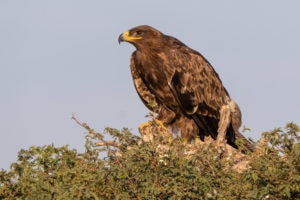
Steppe Eagle 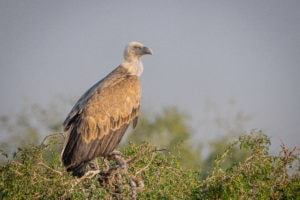
Griffon Vulture © Vijayaditya Singh Rathore 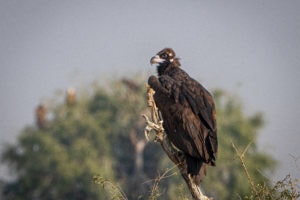
Cinereous Vulture © Vijayaditya Singh Rathore 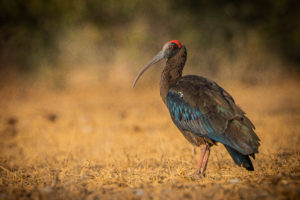
Red-naped Ibis © Vijayaditya Singh Rathore 
Common Starling © Vijayaditya Singh Rathore
We stayed here until after dark, enjoying the wonderful sunset views, and even heard a Savanna Nightjar call as we left.
https://ebird.org/india/checklist/S76575767
The following morning, now accompanied again by Vivek and Mohit, as well as local birder Jitu Solanki (some of us stayed at his simple homestay, Vinayak Guest House, while the rest used a more comfortable and conveniently located hotel), we first went to an area nearby to try to get closer views of the Yellow-eyed Pigeons. This we managed well, including seeing them perched together with Feral Pigeons, allowing a nice comparison of the clear differences. A Eurasian Wryneck and Desert Whitethroat were also seen well here.
https://ebird.org/india/checklist/S76583413
Once again, we split up, with Vivek and Mohit, and Digvijay and Vijayaditya heading to Jorbeer, whilst the rest of decided to explore a bit first, and went to Bhojan Shala, a waterbody nearby. There was a nice selection of waterbirds present, including Common Shelduck and Mallard, both fairly scarce species in India, plus Kentish Plover and Dunlin, a single Black-headed Gull, and a small flock of Greater Flamingo flew overhead several times before deciding not to settle here. A pair of Sind Sparrows were present in the single tree in the middle of an empty field.
Yellow-eyed Pigeons were here in huge numbers, with flocks coming down to drink, and perching on the overhead wires—interestingly each one sat an exact pigeon-sized space away from its neighbour, which I’ve never noticed with Feral Pigeons. Social distancing pigeon-style!
https://ebird.org/india/checklist/S76583431
We then returned to the carcass dump, where there were similar numbers and variety of birds as the previous day.
https://ebird.org/india/checklist/S76583438
Bikaner to Jaisalmer, via Khichan
Leaving Bikaner, we started on the long drive to the camp in the desert near Sam, west of Jaisalmer, which was to be our base for the next three nights. We had a very quick stop at Diyatra, formerly one of the strongholds of Great Indian Bustard but with irregular sightings these days. Rather than explore here though, we wanted to concentrate on better habitat near Pokhran, and also check the Demoiselle Cranes at Khichan.
Khichan is a famous site and a must-visit on a tour of western Rajasthan. The wintering flock of several thousand Demoiselle Cranes are attracted to grain put out by the local villagers who welcome their arrival, and morning and evening feeding times are an amazing sight. Whilst we were at the wrong time for that, there are always flocks present in the surrounding area all day and we spent some time listening and watching a close group of 1,600 birds.
https://ebird.org/india/checklist/S76584660
Vivek had to head back to Delhi rather than continue on to Desert National Park, so our group parted company at Khichan. Mohit and Vivek spent the night here, enjoying the spectacle of about 4,000 cranes feeding in the morning. They then drove back to Delhi, with a one-night stay near Surajgarh to break the journey and to do some birding with Surat Singh Poonia at some of his local patches. This included seeing an incredible number of both wintering Long- and Short-eared Owls, the former especially unusual in India. Due to disturbance, particularly from photographers unfortunately, the exact location, which S S Poonia has watched for a number of years, needs to be kept secret. White-bellied Minivet was another notable find here.
https://ebird.org/checklist/S76662159 (location incorrect to protect sensitive species)

Long-eared Owl © Vivek Menon 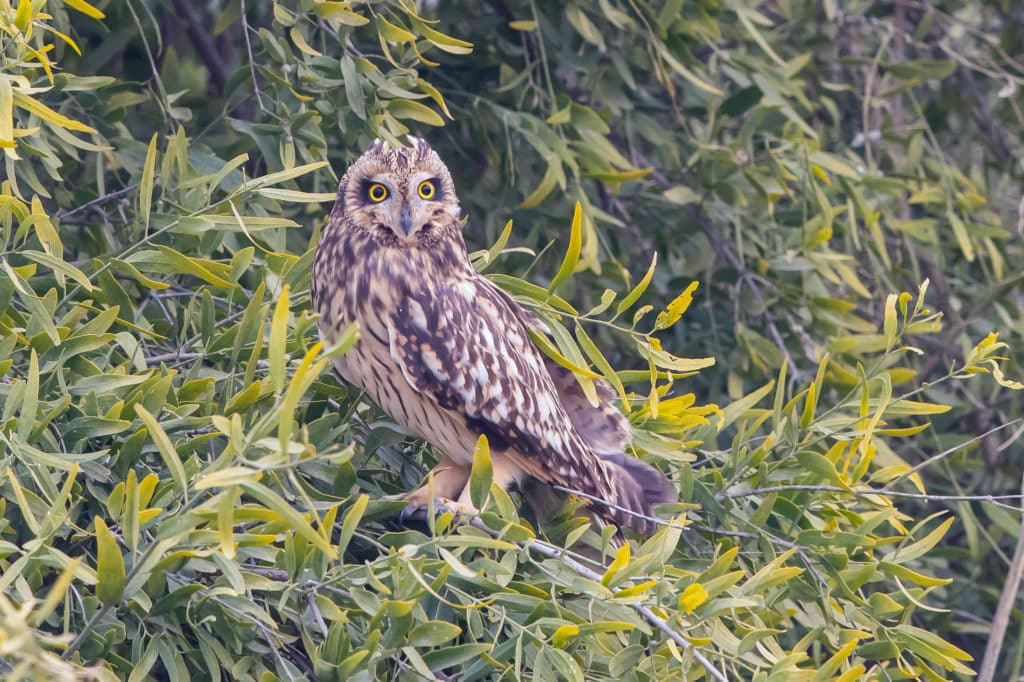
Short-eared Owl © Vivek Menon
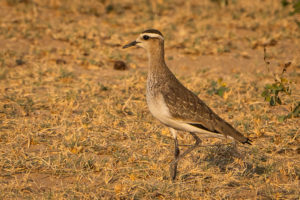
The rest of us continued west, reaching an area near Pokhran for some birding before dark. Here we met local birder/photographer Divesh Kumar Saini, who on arrival told us about a Sociable Lapwing he’d found there a couple of weeks previously! Within a few minutes we were watching a fantastic juvenile bird, which allowed close approach and some excellent photos. Small numbers of this highly endangered species have recently been discovered to winter regularly in parts of Rajasthan and Gujarat.
With not much time before dark we were also able to enjoy a lovely flock of Cream-coloured Coursers, the first of several sightings over the next couple of days, together with a single Indian Courser. A small group of Water Pipits was also a nice find.
https://ebird.org/india/checklist/S76586684
By the time we arrived at our comfortable camp in the desert near Sam, the Paddav “Luxury” Camp, it was quite late. We enjoyed a cold beer and an excellent dinner and discussed the plans for the next day.
Desert National Park
The Desert National Park in the Thar Desert is probably the best arid habitat in India, with several species difficult to see elsewhere. Star of course is the critically endangered Great Indian Bustard, whose precarious hopes for survival hinge on increasing local conservation measures, particularly protection of habitat from development.
Our first priority was to visit the most likely area to find Great Indian Bustards, in and around the fenced enclosure at Sudasari. When we arrived, we saw a group of Eurasian Griffons at a carcass, and with them was one White-rumped Vulture, now a rare sighting anywhere. We also had excellent views of Bimaculated Larks, feeding with Greater Short-toed.
https://ebird.org/india/checklist/S76673933
Digvijay had arranged permission for us to drive in his 4×4 inside the enclosure, and we slowly went around, scanning constantly. The most abundant bird was House Sparrow, much of northwest India seeing large flocks of one of the wintering subspecies—these are often assumed to be parkini, “Kashmir House Sparrow” from the western Himalayas, but are likely to also include the completely migratory bactrianus, from further north into Central Asia. We flushed a Common Quail from the path, and more raptors included a few Cinerous Vultures, Tawny and Steppe Eagles, Eurasian Sparrowhawk, a first calendar-year Hen Harrier, and a pair of Laggar Falcons.
We waited near a watering hole for a while and were treated to close comparisons of Greater Short-toed and Bimaculated Larks really illustrating the significant size difference, plus Black-crowned Sparrow Larks and Red-tailed Wheatear.
A small flock of Yellow-eyed Pigeons circled a few times and landed nearby, but unfortunately didn’t come in to drink—they really are quite shy birds, unsurprisingly considering the amount of hunting they are subjected to, and our presence, albeit a little distant from the water, was probably still enough to put them off at that time.
https://ebird.org/india/checklist/S76674012
Enjoyable though the birding was, we didn’t see any bustards, so tried another area, this time west of the main road. The bird selection was similar, also including a lovely male Pallid Harrier and a Stoliczka’s Bushchat. We slowly drive up a ridge which would give us an excellent vantage point to scan the vast area ahead and, immediately over the top, was an incredibly close pair of Great Indian Bustards! Unfortunately, too close, for they immediately took off and we watched them fly off into the distance and away, but a thrilling moment, nevertheless.
https://ebird.org/india/checklist/S76674094
One of the benefits of the coronavirus restrictions for us is that remote working is the norm, so Vijayaditya was able to attend an online lecture via his laptop in the car at Sudasari! Whilst he did this the rest of us took another round through the main Sudasari enclosure, adding Short-toed Snake Eagle and Eastern Orphean Warbler.
https://ebird.org/india/checklist/S76674140
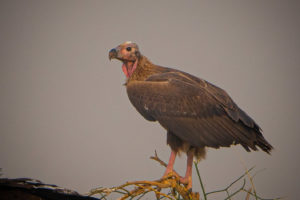
We were then met by local guide Uras Khan, part of the “Godawan Mitra” (Great Indian Bustard Friends) programme of community members who are employed to monitor bustards and other local wildlife. Digvijay and Vijayaditya were keen to go with him to find Trumpeter Finch and Red-headed Vulture, whilst the rest of us decided we’d rather do some exploring on foot, so we split up for the rest of the afternoon.
Both groups were successful, Vijayaditya getting excellent photos of those two target birds, whilst we chanced upon a brilliant group of three female Great Indian Bustards which we were able to watch walking through the grassland for about 15 minutes. We also saw two Asian Desert Warblers. They have a curious habit of following wheatears from bush to bush to feed. In this case, one followed a Variable and the other a Desert; I’m aware of them following both Isabelline and Mourning Wheatears in the Middle East as well! Digvijay and Vijayaditya joined us at the bustards, but unfortunately by the time they arrived the birds had all walked behind some bushes in the distant grassland and remained frustratingly out of sight!
https://ebird.org/india/checklist/S76674209
For the next day Uras accompanied us throughout and was a great help with some specific local knowledge and directions, even though he almost always mixed up his left and right! Human pressure is the greatest threat to the survival of Great Indian Bustard, and hence the involvement of the local community, through people like Uras, is crucial for its survival. The support from groups like us visiting the area is also important.
We decided first thing to try a waterbody to the north, which in some years has Black-bellied Sandgrouse come to drink. Previously known as Imperial Sandgrouse, this used to be an incredibly common bird, occurring in flocks of several thousand, but hunting especially has caused a drastic decline in Asia. Unfortunately, we had no luck, but super views of a Greater Hoopoe-Lark in the nearby desert, together with close Cream-coloured Coursers, made up for that.
https://ebird.org/india/checklist/S76666058
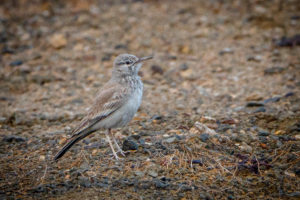
Greater Hoopoe-Lark © Vijayaditya Singh Rathore 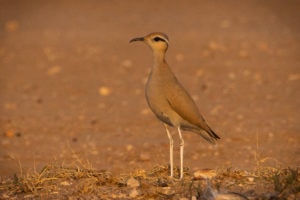
Cream-coloured Courser © Vijayaditya Singh Rathore
The waterbody was productive birding however, with waders including Spotted Redshank, Kentish Plover, Temminck’s and Little Stints, eight species of ducks, four species of wheatears, and three of wagtails.
https://ebird.org/india/checklist/S76665829
Exploring the general area, we found several hundred Chestnut-bellied Sandgrouse, although we arrived just as they were leaving a drinking pool.
https://ebird.org/india/checklist/S76665811
A chance stop beside the road when we saw a vulture from the car ended up producing an amazing 10 species of raptors in 10 minutes, including five vulture species.
https://ebird.org/india/checklist/S76665728

Returning to Sam, we then spent the afternoon doing a series of small birding stops between Sam and Khuri, from the Khabha Fort road, whenever we saw interesting habitat—which actually is most of the area! A small waterhole gave us close views of an amazing 45 Trumpeter Finches, we found Desert Larks at multiple places, and chanced upon a wonderful Indian Eagle Owl in a small stand of acacias. As it flew out it was dramatically dive-bombed by a pair of Laggar Falcons that appeared from nowhere—the action was all over in a few seconds before we had hardly had a chance to grab a breath. It was then that Deepak appeared from behind a bush to greet us with a “seen anything?”—if it wasn’t for the single photo that Salil managed I’m still not sure he would believe us!
https://ebird.org/india/checklist/S76665667
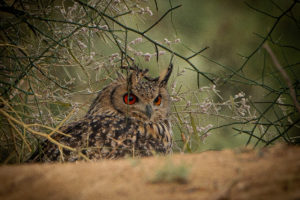
Indian Eagle-Owl © Vijayaditya Singh Rathore 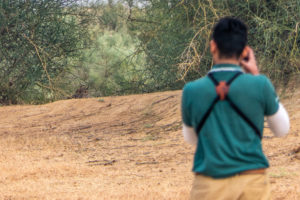
Photographing Indian Eagle Owl
Our longest stop was at a fascinating abandoned Paliwal village, where old cenotaphs just lay in the rubble. It’s an awe-inspiring place, and I wandered around enjoying the experience—and looking for buntings—until Uras told me to come away because (seriously) “a ghost might just come and sit on my shoulder”! Happily, that didn’t happen, and I also found a Striolated Bunting not too far away. This site was especially good for Desert Larks and Red-tailed Wheatears, and we were treated to close views of a family of recently fledged Chestnut-bellied Sandgrouse.
https://ebird.org/india/checklist/S76665131
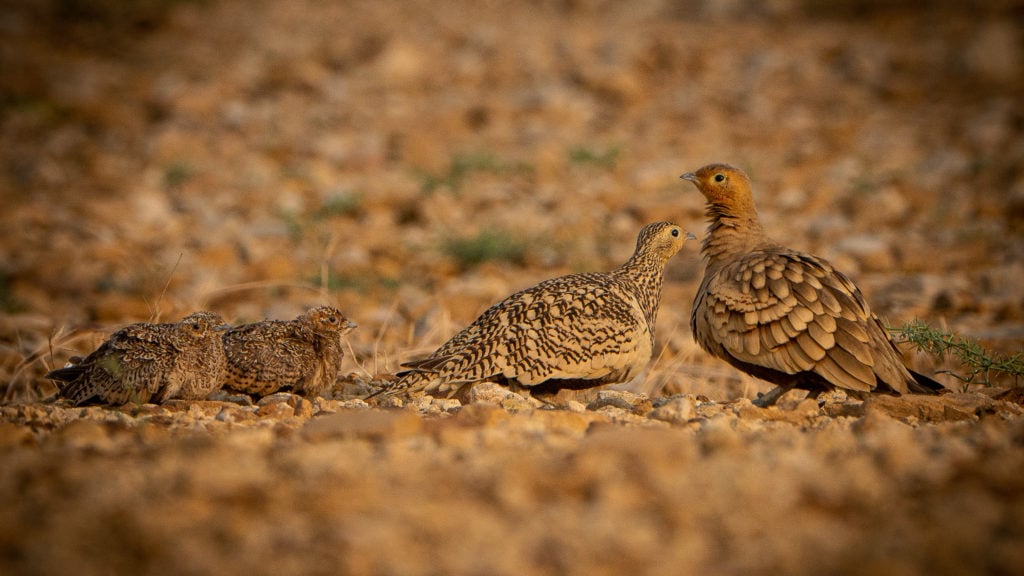
Continuing on towards the area we had been yesterday we were lucky to find another group of Great Indian Bustards, this time two males and two females. They were distant, but still flew when we were a long way off. This meant we had seen 10 different individuals in our two days—not far off 10% of the remaining global population!
https://ebird.org/india/checklist/S76665097
Jaisalmer to Jodhpur, via Khetolai
With a long drive today, we set off before dawn so that we could manage some birding at Khetolai, meeting up with Divesh Kumar Saini again, and also Radheshyam Pemani Bishnoi, another local community volunteer. A large flock of Greater Short-toed Larks came down to drink, giving excellent photo opportunities.
We had our best views of Desert Whitethroat here, a separate species according to IOC but treated as a subspecies by eBird and Clements. One adult was quite distinctive but most “Lesser” Whitethroats are tricky, and the taxonomy and identification are definitely confusing. Another Asian Desert Warbler here followed one of the Desert Whitethroat—the first time I’ve seen one clearly associating with a bird that isn’t a wheatear!
https://ebird.org/india/checklist/S76699139
Divesh then took us to a remote carcass dump, where we had good close views of many Eurasian Griffons and a few Himalayan Griffons with them. Indian Vulture is regular here apparently, but not whilst we were watching. However, when we returned to the main road, we were lucky to see one flying close overhead: our only one on this trip.
https://ebird.org/india/checklist/S76699817
The drive on to Jodhpur gave us a few roadside raptors, including two sightings of Bonelli’s Eagles. Here we parted company with Digvijay and Vijayaditya, and Deepak, Salil and I continued on to Pushkar where we were staying the night. We had hoped to visit Rao Jodha Desert Rock Park in Jodhpur, as this has held a couple of confusing Scops Owls recently—both Pallid and Eurasian have occurred here—but reluctantly decided to skip it rather than arrive too late at Pushkar.
Pushkar
Outside Pushkar are extensive areas of acacia thorn forest, and it is one of the more reliable places to find White-naped Tit. After a while of searching, we succeeded in finding them, and a wonderful flock of 12 White-bellied Minivets. There were some other new birds for the trip here, including White-bellied Drongo, Sulphur-bellied Warbler and Taiga Flycatcher.
https://ebird.org/india/checklist/S76737158
Anasagar Lake is in the centre of Ajmer but attracts a lot of birds. There was a large flock of Black-headed Gulls, with a few Brown-headed and three Lesser Black-backed Gulls, almost certainly barabensis “Steppe” Gulls—one adult had quite a pale mantle, but the shape did not suggest Caspian Gull. Waders included Pied Avocets, Common Redshank, Marsh Sandpiper, and a large flock of Ruff. There were two Great White Pelicans, but unfortunately no Dalmatian.
https://ebird.org/india/checklist/S76737223
Okhla Bird Sanctuary
On the edge of Delhi and along the Yamuna River, we often visit Okhla Bird Sanctuary at the start or end of tours. There are a few birds here that are not easy to find elsewhere, and the last morning succeeded in finding three of these: Yellow-bellied Prinia, Striated Grassbird and Striated Babbler. The excellent selection of birds overall, also including White-tailed Lapwing, Pallas’s Gull, Moustached and Greenish Warblers, and Common Rosefinch, was a fitting end to a successful short tour.
https://ebird.org/india/checklist/S76783775


